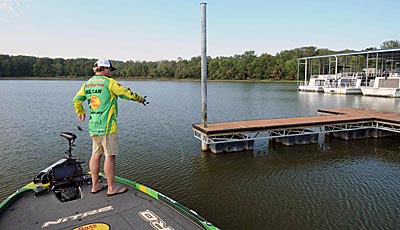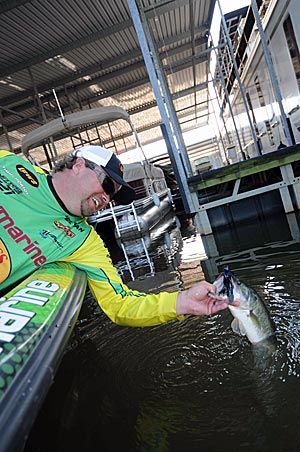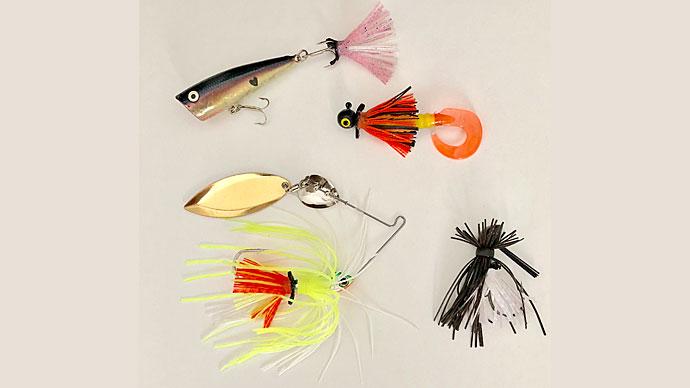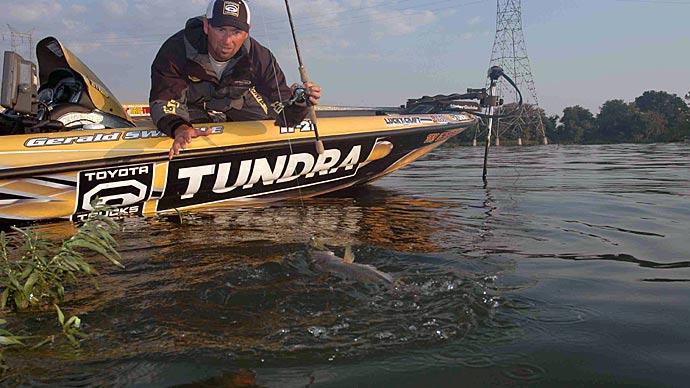
When shad and bluegill rise high in the water column during autumn, Tim Horton knows it’s prime time to swim a jig.
Fall nights with temperatures in the 50-degree range start cooling down the surface water, prompting baitfish to seek a new comfort zone. “The baitfish come up higher in the water column because the cooler temperatures are more comfortable for them,” Horton says. The Alabama pro knows he needs to tempt bass with a lure he can keep near the surface because bass will be looking up for their prey.
Topwater lures, buzz baits, and spinnerbaits are all ideal lures for working across the surface throughout the fall, but increased fishing pressure causes bass to start ignoring these action baits. So Horton tempts these fish with a more subtle presentation of swimming a jig along the surface.
The five-time B.A.S.S. winner favors swimming a jig around any available cover in the fall. “Marinas are exceptional because many fish stay on the floating piers instead of staying deep on the cables then,” Horton says. “If I find an isolated private dock along a bank, I never pass it up because so many fishermen will.” He sometimes runs a pattern of isolated docks making a cast or two to each dock before running to another pier.
Laydown trees or wood cover are good targets for Horton to swim a jig. “It is phenomenal around any vegetation like hydrilla, milfoil, or water willows on the outside edges,” he says.
When targeting vegetation, Horton searches for the thickest section of weeds to swim his jig. “Most of the time, the bass are going to set up on the outside of it because they have a window to ambush, and the water is a little bit deeper there, which makes them feel a little bit more secure,” he says.

Swimming a jig produces best for Horton around shallow cover. However, he has caught bass off of docks sitting over deep water. He notes bass on clear water lakes such as Table Rock will “smoke” a swim jig that stays close to the foam of docks in water 30 to 40 feet deep.
“This technique will work in all water color scenarios,” Horton says. Stained water is usually best for swimming a jig because the low visibility prevents bass from getting a good look at the lure as it passes by them. However, Horton has also caught bass on the tactic at Alabama’s Smith Lake, where he could see the bottom at 10 to 15 feet deep.
A swim jig is also effective during sunny or cloudy weather. “When you get the sun, you have to be real cognizant of the shade,” Horton says. “Anytime you pull up on docks, you look for the darkest water under the docks, and that is where the bass are going to be.”
Horton favors a 7/16-ounce Swampers Gary Klein Swim Jig tipped with a soft plastic craw for his swimming tactics. He prefers a craw trailer because the lure’s pincers kick and jump, creating a great swimming action. “It can either be perceived as a crawfish skimming along the surface or a bream swimming or something like that,” Horton says. Horton opts for a bulky craw trailer, which gives the lure more buoyancy allowing him to keep the swim jig on the surface easier.
The color choices for Horton’s swim jig combo depend on the cover he is fishing. When swimming a jig around docks and marinas, he opts for a black-and-blue jig with a green pumpkin trailer. “I like to use those colors because they blend in and are not quite as loud,” he says. “So it imitates the bluegill a little bit more.” If Horton is fishing around the outside edges of hydrilla where threadfin shad congregate, he will choose a white swim jig and trailer to imitate the baitfish.
When fishing around docks, Horton tries to have his jig undulate along the surface, similar to waking a spinnerbait. “I like to bubble the surface with that swim jig,” he says. “I like to keep that jig up and create a wake and make it irregular almost to where it is like a baitfish trying to get away.”
The Alabama pro slows down his presentation when fishing in grass, so the jig swims lower in the water column. The slower retrieve allows Horton to bump his jig into the water willows or cut through the hydrilla. Horton’s gear for all his swim jig presentations consists of a 7-foot, 3-inch medium-heavy Duckett Fishing Rod and a Team Lew’s Custom Pro baitcast reel filled with 30-pound Bass Pro Shops XPS Braid line.
Although a swim jig is more of a finesse topwater presentation, it still produces big bass for Horton because he uses a power fishing lure around heavy cover. “The biggest fish in the lake are going to live in that heavy cover whether it is boat docks, marinas, or vegetation,” Horton surmises.




